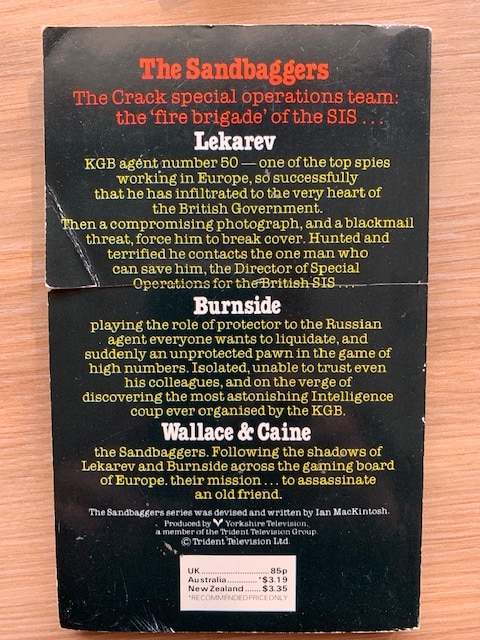THE SANDBAGGERS (THINK OF A NUMBER) by Donald Lancaster (Corgi, 1980)
The Sandbaggers was a highly regarded television series about the eponymous British Intelligence unit, also known as the“fire brigade of the SIS”, that ran on British TV between 1978 and 1980. It was created by Ian Mackintosh, who wrote all the episodes for the first two seasons and four of the episodes for the third, before he went missing in a much speculated about plane crash near the Russian border.
Mackintosh also wrote a novel based on the first two episodes of the series, The Sandbaggers (Corgi, 1978). It was quite a good book and a useful introduction to the series.
Following the death of Mackintosh, it would seem that Donald Lancaster (a pseudonym for William Marshall, the Australian born author of the Hong Kong-based Yellowthread Street mystery novels) was approached to quickly produce a new novel based on the series to capitalise on the death of Mackintosh. The result was The Sandbaggers: Think of a Number.
Think of a Number is based primarily in Switzerland (not Hong Kong as some sources suggest) and revolves around the defection in Geneva of a high-level KGB agent, Lekarev. He is a ‘number’, the lexicon given to the most senior Russian agents who are only known by their number. Lekarev is agent number 50 and has details on high level Russian spies working in the British Government. At Lekarev’s request, Neil Burnside, the head of the ‘Sandbaggers’, is sent to Geneva to protect Lekarev and bring him in. However, by the time Burnside gets to Geneva the importance of Lekarev and the dangerous information he holds filters through the main Intelligence agencies and Burnside finds himself on the run with Lekarev, pursued by the KGB, his own colleagues and mysterious third party.
Think of a Number has often been dismissed as a poorly conceived offspring of the television series, but on re-reading it I found it to be an enjoyable spy yarn with plenty of action and a good dose of cynicism. The book moves at a good pace and the action scenes are well choreographed and exciting. There are some neat twists and the book builds to a cynical ending, that would not have been out of place in the television series (as I remember it). Admittedly, the characterisations are very thin, although Lancaster seems to capture the growing disillusionment of Burnside quite well. In other hands the plot would have been fleshed out and expanded more, but that would have detracted from the quick, television inspired pace of the book.
There are some flaws to the story. The central conceit of a Russian spy who knows so much about the infiltration of the British Government that he, and everyone he comes in contact with, has to be eliminated on sight before they can talk does not hold up well. It might have been more credible in the paranoid times of the late 1970 and 80s, but it lacks logic in 2019. The other flaw revolves around the involvement of a third party, in addition to the British SIS and the KGB, in the search for Lekarev. I won’t say who they are, as it is only revealed late in the book, but their involvement does not make a lot of sense. It is also not clear how they established the connection with Lekarev. Again, it may have been more credible in 1980.
Think of a Number has been criticised for not capturing the spirit of the show. I find it hard to comment on this, as I have only seen a few of the episodes over the years, as it never enjoyed wide or regular release in Australia. It is probably a miracle that I picked up a copy of the book in the early 1980s. I think that I mainly bought it in the hope that the show would come to Australia and because I had enjoyed the first book. Nevertheless, I am glad I did and it was fun re-reading it after all this time.
RATING: 4 out of 5


